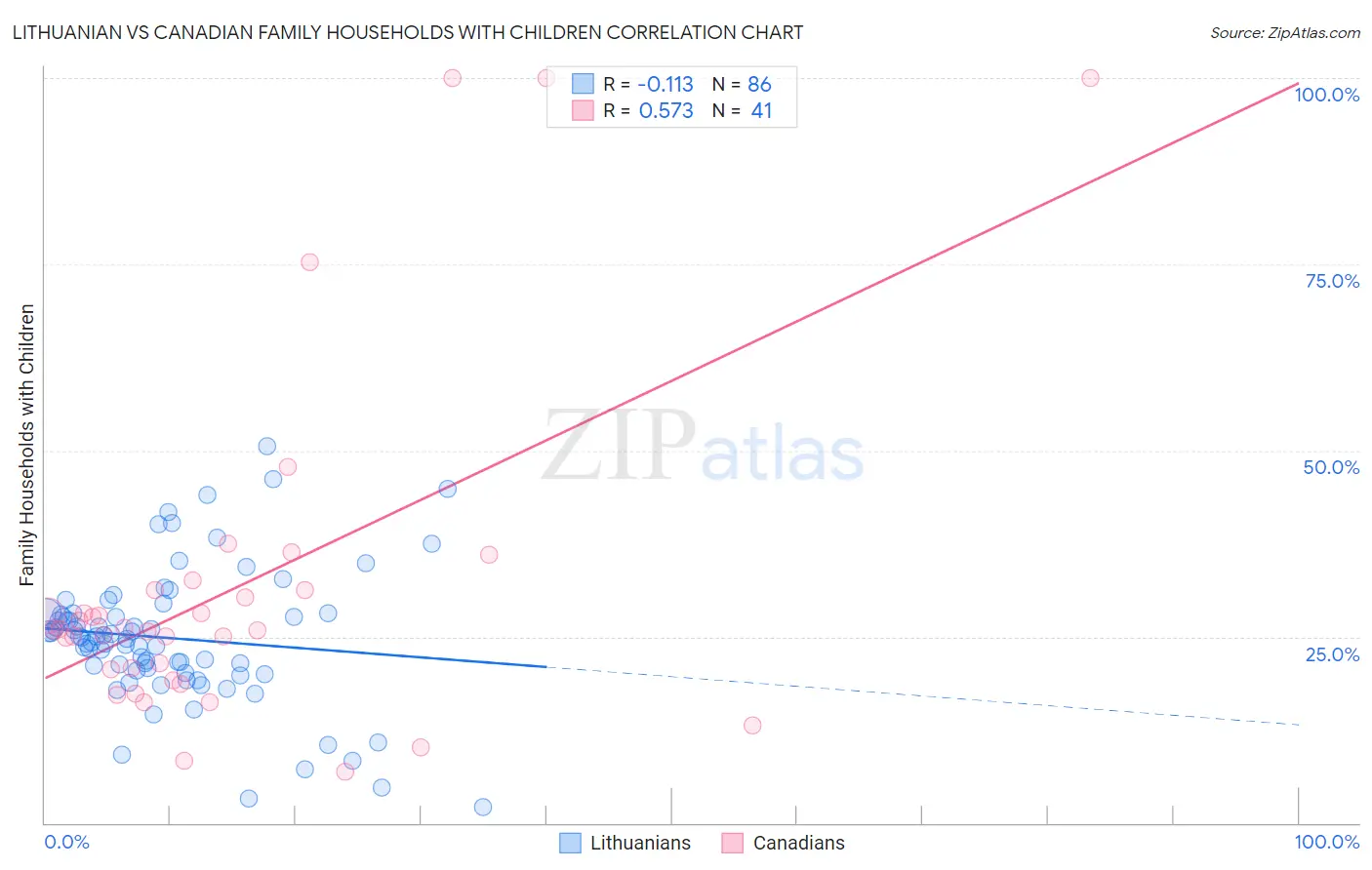Lithuanian vs Canadian Family Households with Children
COMPARE
Lithuanian
Canadian
Family Households with Children
Family Households with Children Comparison
Lithuanians
Canadians
26.6%
FAMILY HOUSEHOLDS WITH CHILDREN
0.3/ 100
METRIC RATING
281st/ 347
METRIC RANK
27.1%
FAMILY HOUSEHOLDS WITH CHILDREN
7.5/ 100
METRIC RATING
225th/ 347
METRIC RANK
Lithuanian vs Canadian Family Households with Children Correlation Chart
The statistical analysis conducted on geographies consisting of 421,521,006 people shows a poor negative correlation between the proportion of Lithuanians and percentage of family households with children in the United States with a correlation coefficient (R) of -0.113 and weighted average of 26.6%. Similarly, the statistical analysis conducted on geographies consisting of 437,085,688 people shows a substantial positive correlation between the proportion of Canadians and percentage of family households with children in the United States with a correlation coefficient (R) of 0.573 and weighted average of 27.1%, a difference of 1.9%.

Family Households with Children Correlation Summary
| Measurement | Lithuanian | Canadian |
| Minimum | 2.2% | 6.9% |
| Maximum | 50.6% | 100.0% |
| Range | 48.4% | 93.1% |
| Mean | 24.8% | 31.4% |
| Median | 25.0% | 26.0% |
| Interquartile 25% (IQ1) | 20.4% | 19.9% |
| Interquartile 75% (IQ3) | 28.1% | 31.3% |
| Interquartile Range (IQR) | 7.7% | 11.4% |
| Standard Deviation (Sample) | 9.1% | 22.5% |
| Standard Deviation (Population) | 9.0% | 22.2% |
Similar Demographics by Family Households with Children
Demographics Similar to Lithuanians by Family Households with Children
In terms of family households with children, the demographic groups most similar to Lithuanians are French American Indian (26.6%, a difference of 0.010%), Immigrants from North America (26.6%, a difference of 0.080%), Senegalese (26.6%, a difference of 0.090%), Immigrants from Canada (26.5%, a difference of 0.10%), and Finnish (26.6%, a difference of 0.12%).
| Demographics | Rating | Rank | Family Households with Children |
| Eastern Europeans | 0.6 /100 | #274 | Tragic 26.7% |
| Immigrants | Northern Europe | 0.5 /100 | #275 | Tragic 26.7% |
| Immigrants | Spain | 0.5 /100 | #276 | Tragic 26.6% |
| Celtics | 0.4 /100 | #277 | Tragic 26.6% |
| Immigrants | Europe | 0.4 /100 | #278 | Tragic 26.6% |
| Finns | 0.4 /100 | #279 | Tragic 26.6% |
| Senegalese | 0.4 /100 | #280 | Tragic 26.6% |
| Lithuanians | 0.3 /100 | #281 | Tragic 26.6% |
| French American Indians | 0.3 /100 | #282 | Tragic 26.6% |
| Immigrants | North America | 0.3 /100 | #283 | Tragic 26.6% |
| Immigrants | Canada | 0.3 /100 | #284 | Tragic 26.5% |
| Cambodians | 0.2 /100 | #285 | Tragic 26.5% |
| Immigrants | Senegal | 0.2 /100 | #286 | Tragic 26.5% |
| Shoshone | 0.2 /100 | #287 | Tragic 26.5% |
| Russians | 0.2 /100 | #288 | Tragic 26.5% |
Demographics Similar to Canadians by Family Households with Children
In terms of family households with children, the demographic groups most similar to Canadians are Czechoslovakian (27.0%, a difference of 0.080%), Tsimshian (27.0%, a difference of 0.080%), Scottish (27.0%, a difference of 0.080%), German (27.1%, a difference of 0.090%), and Immigrants from Caribbean (27.0%, a difference of 0.11%).
| Demographics | Rating | Rank | Family Households with Children |
| Greeks | 11.4 /100 | #218 | Poor 27.1% |
| Immigrants | Japan | 10.7 /100 | #219 | Poor 27.1% |
| Austrians | 9.9 /100 | #220 | Tragic 27.1% |
| New Zealanders | 9.6 /100 | #221 | Tragic 27.1% |
| Paraguayans | 9.4 /100 | #222 | Tragic 27.1% |
| Pima | 9.2 /100 | #223 | Tragic 27.1% |
| Germans | 8.7 /100 | #224 | Tragic 27.1% |
| Canadians | 7.5 /100 | #225 | Tragic 27.1% |
| Czechoslovakians | 6.6 /100 | #226 | Tragic 27.0% |
| Tsimshian | 6.6 /100 | #227 | Tragic 27.0% |
| Scottish | 6.5 /100 | #228 | Tragic 27.0% |
| Immigrants | Caribbean | 6.3 /100 | #229 | Tragic 27.0% |
| Bulgarians | 5.8 /100 | #230 | Tragic 27.0% |
| Luxembourgers | 5.5 /100 | #231 | Tragic 27.0% |
| Yugoslavians | 5.1 /100 | #232 | Tragic 27.0% |